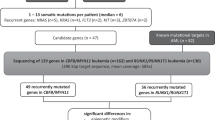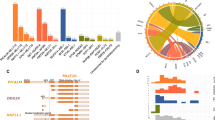Abstract
We evaluated the occurrence of the CBFβ/MYH11 fusion transcripts by PCR analysis in 10 patients with inv(16)(p13;q22) acute myeloid leukemia (AML) who underwent allogeneic bone marrow transplantation (BMT) (n = 5), peripheral blood progenitor cell transplantation (PBPCT) (n = 3), or autologous transplantation (n = 2). In addition to the analysis of minimal residual disease (MRD), the chimerism status of patients after allogeneic transplant was studied by PCR. The CBFβ/MYH11 fusion trancript was not detectable in six of seven patients who remained in remission after allogeneic BMT or PBPCT. Two of these patients in remission were monitored for 50 months and 64 months post-BMT. One patient in remission was PCR-positive for CBFβ3 months post-BMT in a single BM sample, but not in a simultaneously examined blood sample, suggesting that analyses from BM samples are more sensitive than those from blood samples. Sequential PCR assays performed 6 and 12 months post-BMT obtained from the same patient were negative. Another patient with a positive PCR assay 3 months post-allogeneic PBPCT, remained PCR positive for the CBFβ/MYH11 fusion transcript when tested 6 months post-PBPCT. A chimerism analysis by PCR revealed a mixed chimerism status in this patient. He relapsed 7 months post-transplant. Before transplant, in all nine patients who were in complete remission of AML (eight patients in 1CR, one patient in 2CR), the CBFβ/MYH11 transcript was detectable. In one patient in relapse, the fusion transcript was not only detectable in blood and bone marrow, but also in a cerebrospinal fluid sample prior to transplant. Two patients who received autologous BMT were monitored for CBFβ/MYH11 transcripts 3 months after BMT. The CBFβ/MYH11 was detected in these patients. Both patients subsequently relapsed 3 months and 23 months post-autologous BMT. The results study show that analysis of the CBFβ/MYH11 fusion transcript by PCR seems to be a suitable method for monitoring minimal residual disease in AML patients with inv (16).
This is a preview of subscription content, access via your institution
Access options
Subscribe to this journal
Receive 12 print issues and online access
$259.00 per year
only $21.58 per issue
Buy this article
- Purchase on Springer Link
- Instant access to full article PDF
Prices may be subject to local taxes which are calculated during checkout
Similar content being viewed by others
Author information
Authors and Affiliations
Rights and permissions
About this article
Cite this article
Elmaagacli, A., Beelen, D., Kroll, M. et al. Detection of CBFβ/MYH11 fusion transcripts in patients with inv(16) acute myeloid leukemia after allogeneic bone marrow or peripheral blood progenitor cell transplantation. Bone Marrow Transplant 21, 159–166 (1998). https://doi.org/10.1038/sj.bmt.1701056
Received:
Accepted:
Published:
Issue Date:
DOI: https://doi.org/10.1038/sj.bmt.1701056
Keywords
This article is cited by
-
Molecular methods for measurable residual disease in acute myeloid leukemia: where are we and where are we going?
Journal of Hematopathology (2021)
-
Use of Minimal Residual Disease in Acute Myeloid Leukemia Therapy
Current Treatment Options in Oncology (2020)
-
Relapse of AML after hematopoietic stem cell transplantation: methods of monitoring and preventive strategies. A review from the ALWP of the EBMT
Bone Marrow Transplantation (2016)
-
A fast and simple approach for the simultaneous detection of hematopoietic chimerism, NPM1, and FLT3-ITD mutations after allogeneic stem cell transplantation
Annals of Hematology (2014)
-
Minimal residual disease diagnostics in myeloid malignancies in the post transplant period
Bone Marrow Transplantation (2008)



